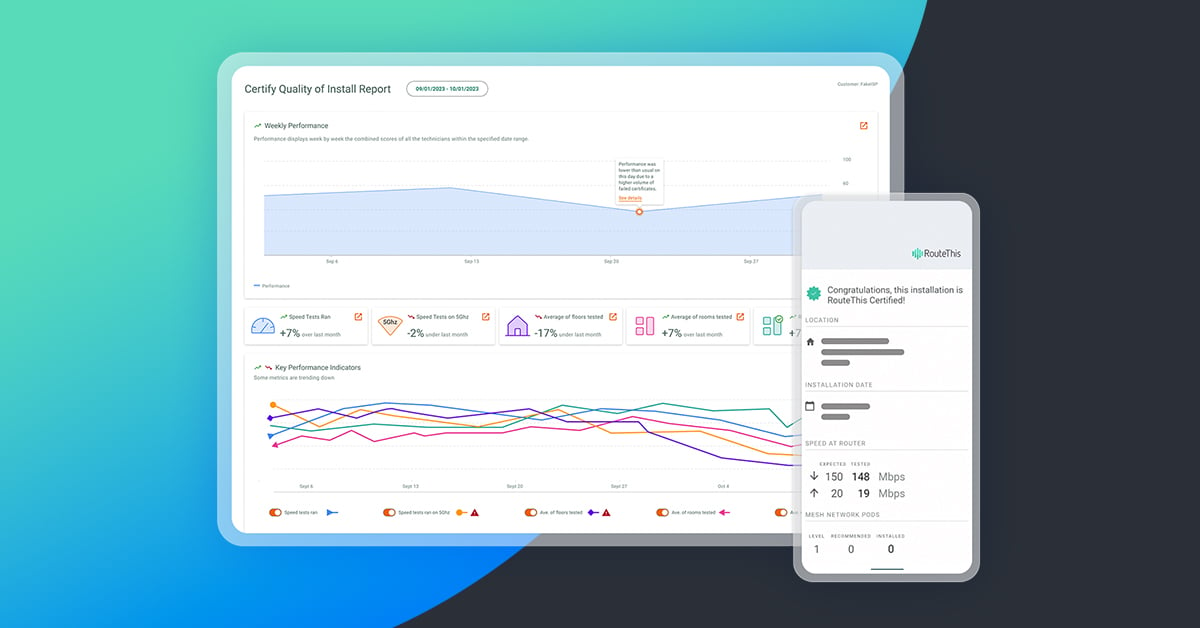How Quality of Install (QoI) helps resolve QoE issues before they happen

In today's competitive broadband market, the fastest speeds or the lowest price is no longer enough to outpace the competition. Even with offerings of Gigabit (or multi-Gigabit) speeds, the incremental increases may not be noticeable to the average customer. For many, the bottom line is which service provider can offer the best overall Quality of Experience (QoE).
Customers expect their internet will ‘just work’ and all of their devices will perform flawlessly in every room — including in the typical U.S. household, which now has 21 connected devices. From security systems and smart speakers to connected appliances and online gaming consoles, the quality of a customer’s home WiFi connectivity is the key performance indicator (KPI) that matters.
Yet, QoE is highly subjective. So, how can you ensure that each customer’s experience is optimized for the highest possible satisfaction, minimize churn and maximize revenue?
Poor Install = Poor QoE
WiFi service quality begins with the home equipment installation and provisioning. Even when you deploy a robust, high-speed network, customers still expect you to resolve issues within the home, beyond the traditional demarcation point. According to our data, 31% of all technical support calls are related to the in-home network.
Consider the scenario where a field technician completes the initial installation and the customer’s devices all connect quickly and smoothly to the internet. That customer enjoys a fabulous QoE. No follow-up calls or repeat truck rolls are needed to get everything right, and the customer is happy.
On the other hand, if a customer is expecting blazing fast WiFi speeds, yet their streaming video is continually buffering, their perceived experience will be poor. When this happens, not only could the issue require costly repeat technician visits to resolve, but you also risk customer churn or negative online reviews. That's why, on average, 15% of service provider churn occurs within the first 90 days; most often due to the customer experience falling short of expectations.
What is QoI?
Currently, the majority of effort spent on most home broadband installations takes place outside the customer’s home. Once the technician achieves a good signal, they may spend a brief time inside completing the install before headed to their next job.
However, the most significant network issues affecting customer experience typically occur inside the home, resulting in unresolved quality issues lingering after the field technician has left. As a result, internet service providers (ISPs) are all too often faced with costly follow-up support calls and repeat truck rolls, leading to dissatisfied customers, a low Net Promoter Score (NPS) and unfortunately, churn and lost revenue.
To ensure that every WiFi install is completed uniformly and successfully, RouteThis developed Quality of Install (QoI) - a quantitative metric that measures, evaluates and validates the home WiFi installation - verifying that outstanding quality was delivered to ensure consistently high QoE from day one. Preventing QoE issues from the beginning can translate into significant cost savings for many service providers.
QoI introduces five key performance indicators (KPIs) that allow service providers to objectively measure and validate home WiFi installation success. Ranging from verification that actual WiFi speeds match plan speeds, to ensuring that no coverage issues are left behind, these QoI KPIs substantiate that every installation is conducted per best practices. Moreover, data collected during the installation process provides a valuable benchmark that can be used for performance optimization over time.
Deliver Quality from Day One
In order to simplify QoI KPI data collection, the RouteThis Certify platform provides field technicians with a streamlined workflow that incorporates best practices via an easy-to-use interface, ensuring that every WiFi installation is a successful one. Once all the KPIs have been achieved, the technician can generate a WiFi certificate to share with the customer, validating flawless connectivity in every room. This data is also available via the RouteThis Certify reporting, allowing for operations leaders to view installation quality by technician, and identify areas for continuous improvement in customer experience and satisfaction.
For most home WiFi customers, an outstanding QoE means the internet always just works. To find out how optimized QoI can help prevent costly QoE issues, and to learn more about QoI from a real RouteThis ISP customer, watch our recent webinar in partnership with the Fiber Broadband Association.
To learn more about QoI and how it can help you optimize installations and improve customer experience, contact RouteThis today.
